Lessons to Learn from Post-Installation Pollution Levels Assessment of Some Distribution Insulators
Abstract
1. Introduction
2. Background on Insulators
3. Experimental Arrangement
3.1. ESDD and NSDD Assessment
3.2. Leakage Current Measurement
4. Results and Discussion
4.1. Leakage Current Assessment
4.2. Phase Difference between Leakage Current and Applied Voltage
4.3. Harmonic Analysis
4.4. Pollution Level Assessment
5. Conclusions
- The 1st, 3rd, and 5th harmonic components may allow monitoring the entire development trend of the leakage current.
- A number of observations by other published papers have been re-confirmed in this paper; the theoretical premises and expectations that the leakage current increases with the insulator’s humidification is verified.
- The observed current is a combination of an increased conductive leakage plus a fairly steady capacitive part.
- The ESDD and NSDD assessments indicate that all the insulators, initially designed for light pollution level, are differently polluted. The pollution level should, therefore, not be considered static. These investigations have confirmed that the local environmental parameters dynamics should be considered for the grid reliability. Post-installation investigations are recommended whenever the surrounding insulator’s area undergo changes (construction, habitation, changes in factory processes, etc.).
Author Contributions
Funding
Acknowledgments
Conflicts of Interest
References
- Papailiou, K.O. Overhead Lines. In CIGRE Green Books; CIGRE: Paris, France, 2017. [Google Scholar]
- EPRI. EPRI AC Transmission Line Reference Book—200 kV and Above, 3rd ed.; EPRI: Palo Alto, CA, USA, 2005. [Google Scholar]
- CIGRE Working Group 33-04, TF 01. Polluted insulators: A review of current knowledge. CIGRE Rep. 2000, 158, 128–129. [Google Scholar]
- IEC TS 60815-1. Selection and Dimensioning of High-voltage Insulators Intended for Use in Polluted Conditions-Part 1: Definitions, Information and General Principles, 1st ed.; International Electrotechnical Commission: Geneva, Switzerland, 2008. [Google Scholar]
- Gençoglu, M.T.; Cebeci, M. The pollution flashover on high voltage insulators. Electr. Power Syst. Res. 2008, 78, 1914–1921. [Google Scholar] [CrossRef]
- Grigsby, L.L. Electric Power Generation, Transmission and Distribution, 3rd ed.; CRC Press: Boca Raton, FL, USA, 2012. [Google Scholar]
- Mishra, A.P.; Gorur, R.S.; Venkataraman, S. Evaluation of porcelain and toughened glass suspension insulators removed from service. IEEE Trans. Dielectr. Electr. Insul. 2008, 15, 467–475. [Google Scholar] [CrossRef]
- Braini, S.M. Coatings for Outdoor High Voltage Insulators. Ph.D. Thesis, School of Engineering Cardiff, Cardiff University, Wales, UK, 2013. [Google Scholar]
- Papailiou, K.O.; Schmuck, F. Silicone Composite Insulators Materials, Design, Applications; Springer: Berlin/Heidelberg, Germany, 2013. [Google Scholar]
- EPRI. Review for the State of the Art and Application of Polymer Materials Insulation used in Distribution Class. (12–46 kV class) Substations; EPRI: Palo Alto, CA, USA, 2003. [Google Scholar]
- Imakoma, T.; Suzuki, Y.; Fujii, O.; Kawamura, S. Electrical and mechanical characteristics of non-ceramic phase-to-phase spacers and akimbo insulator assemblies. In Proceedings of the SEE Conference, Paris, France, 7–8 June 1994. [Google Scholar]
- Contreras, J.E.; Rodríguez, E.A. Nanostructured insulators–A review of nanotechnology concepts for outdoor ceramic insulators. Ceram. Int. 2017, 43, 8545–8550. [Google Scholar] [CrossRef]
- Dave, V.; Dubey, P.; Gupta, H.O.; Chandra, R. Nanotechnology for outdoor high voltage insulator: An experimental Investigation. Int. J. Chemtech Res. 2013, 5, 666–670. [Google Scholar]
- Portella, K.F.; Mengarda, P.; Bragança, P.M.; Ribeiro, S.; Santos de Melo, J.; Pedreira, C.D.; Pianaro, S.; Mazur, M.M. Nanostructured titanium film deposited by pulsed plasma magnetron sputtering (Pdms) on a high voltage ceramic insulator for outdoor use. Mat. Res. 2015, 18, 853–859. [Google Scholar] [CrossRef][Green Version]
- Li, J.Y.; Sun, C.X.; Sima, W.X.; Yang, Q.J. Stage pre-warning based on leakage current characteristics before contamination flashover of porcelain and glass insulators. IET Gener. Transm. Distrib. 2009, 3, 605–615. [Google Scholar] [CrossRef]
- Fofana, I.; Borsi, H.; Gockenbach, E. Fundamental Investigations on Some Transformer Liquids under Various Outdoor Conditions. Trans. Dielectr. Electr. Insul. 2001, 8, 1–8. [Google Scholar] [CrossRef]
- Palangar, M.F.; Mirzaie, M. Detection of Critical Conditions in Ceramic Insulators Based on Harmonic Analysis of Leakage Current. Electr. Power Compon. Syst. 2016, 44, 18541–18864. [Google Scholar] [CrossRef]
- Ahmadi-Joneidi, I.; Shayegani-Akmal, A.A.; Mohseni, H. Leakage current analysis of polymeric insulators under uniform and non-uniform pollution conditions. IET Gener. Transm. Distrib. 2017, 11, 2947–2957. [Google Scholar] [CrossRef]
- Zheng, Q.; Liu, S.; Yang, S.; Lei, J.; Peng, X.; Lin, C. Influence of insoluble substance hygroscopicity on insulator leakage current. In Proceedings of the International Conference on High Voltage Engineering and Application (ICHVE), Chengdu, China, 19–22 September 2016. [Google Scholar]
- Hussain, M.M.; Chaudhary, M.A.; Razaq, A. Mechanism of Saline Deposition and Surface Flashover on High-Voltage Insulators near Shoreline: Mathematical Models and Experimental Validations. Energies 2019, 12, 3685. [Google Scholar] [CrossRef]
- Vosloo, W.L. A Comparison of the Performance of High-Voltage Insulator Materials in a Severely Polluted Coastal Environment. Ph.D. Thesis, University of Stellenbosch, Stellenbosch, South Africa, 2002. [Google Scholar]
- Chen, S.; Zhang, Z. Dynamic pollution prediction model of insulators based on atmospheric environmental parameters. Energies 2020, 13, 3066. [Google Scholar] [CrossRef]
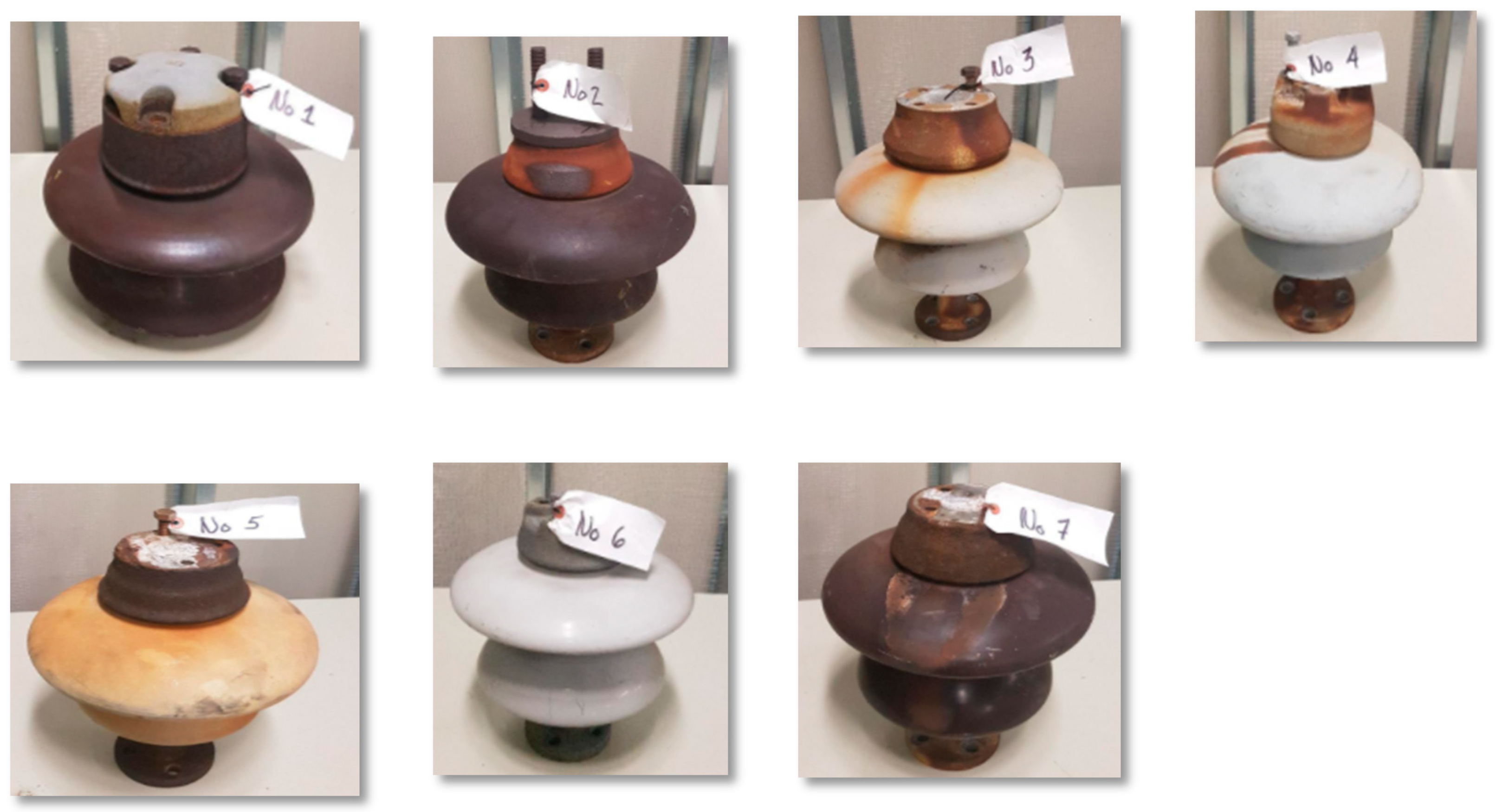
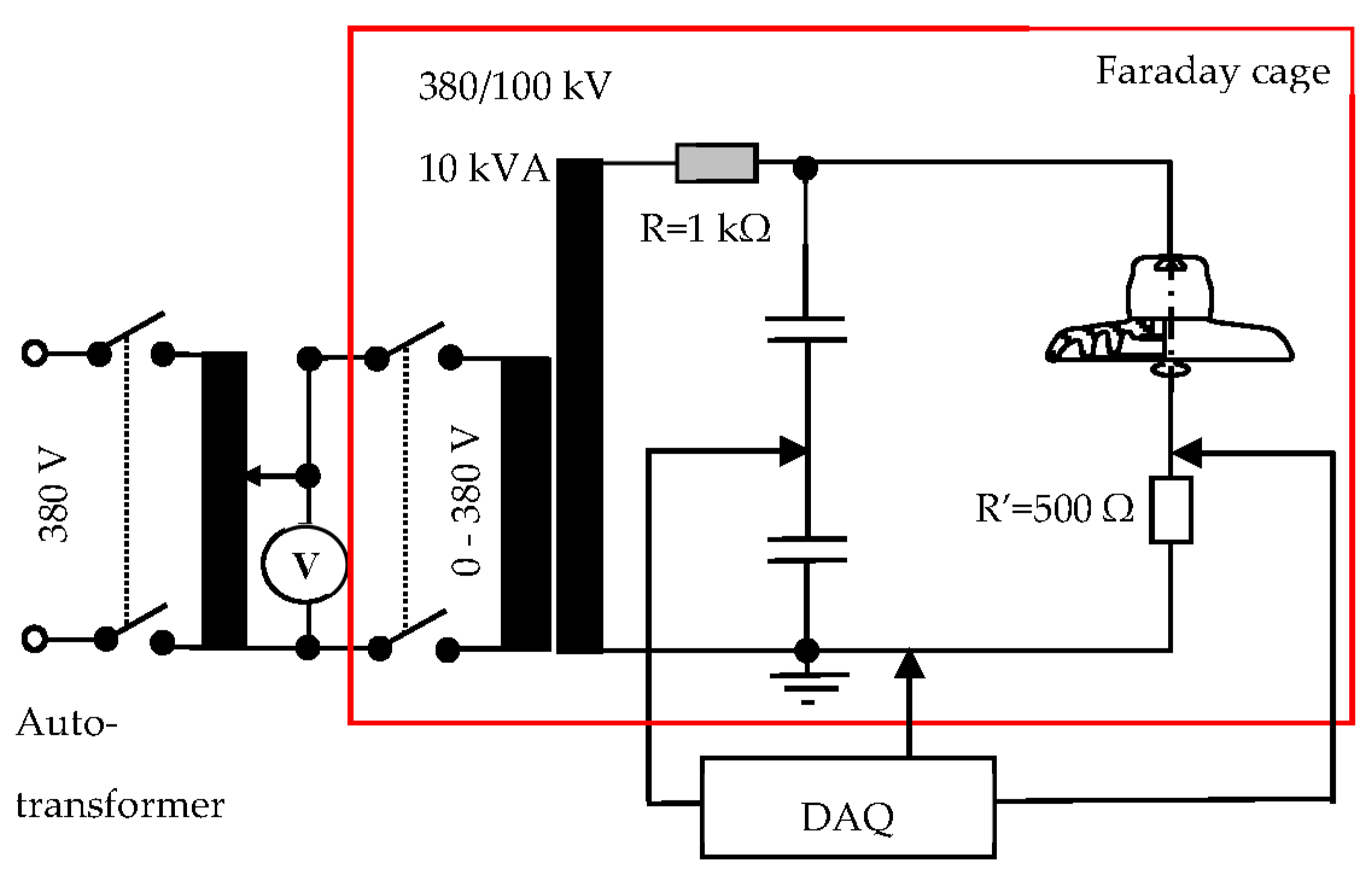
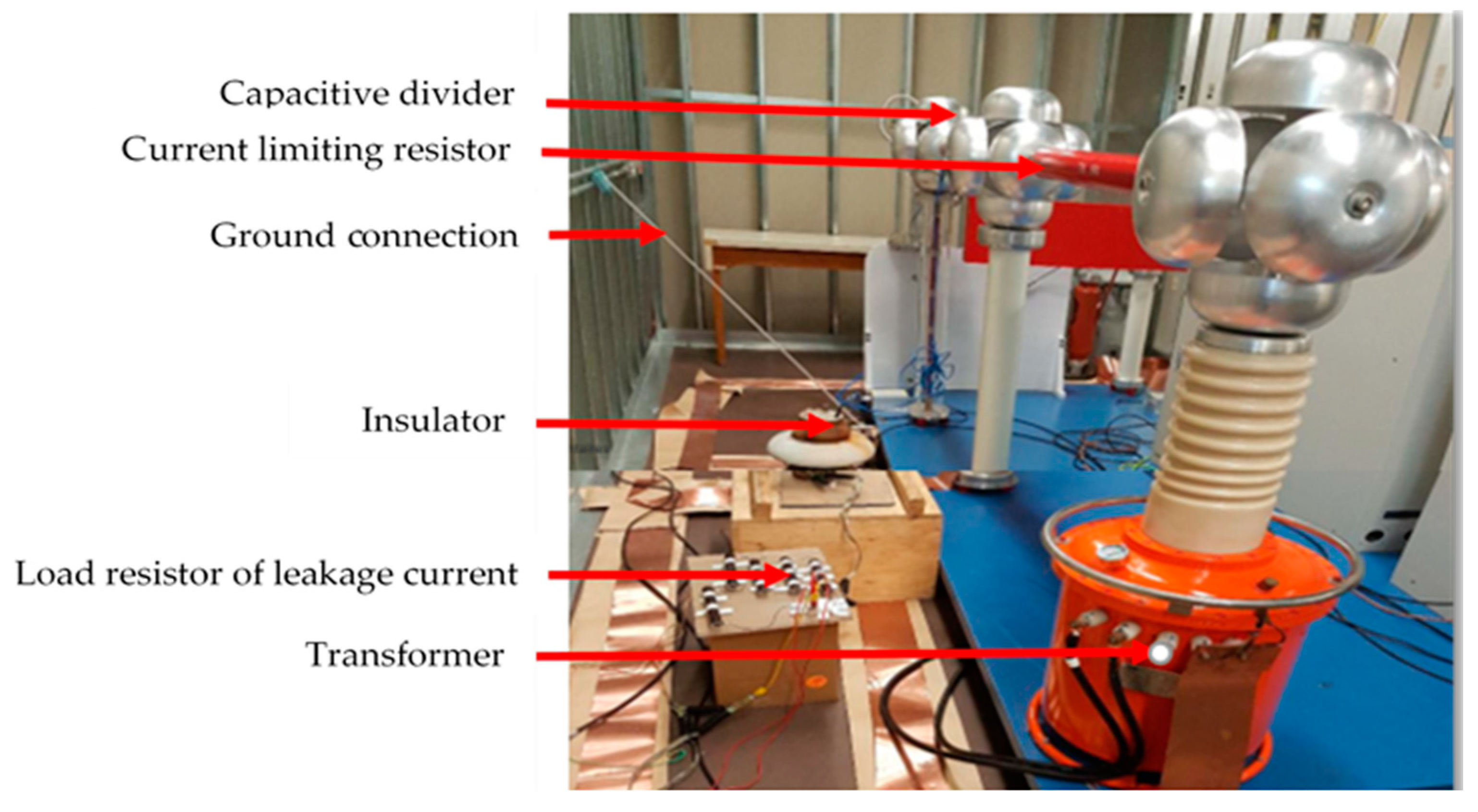
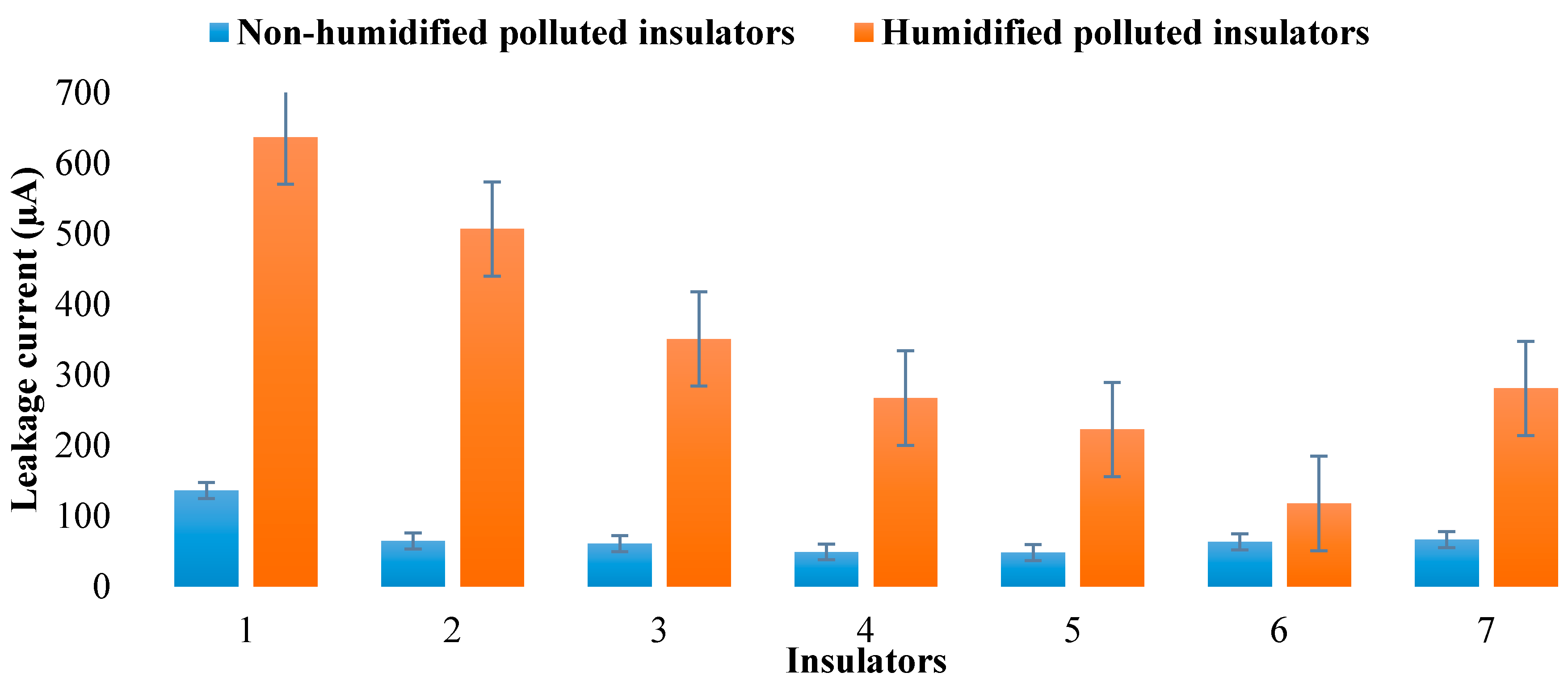
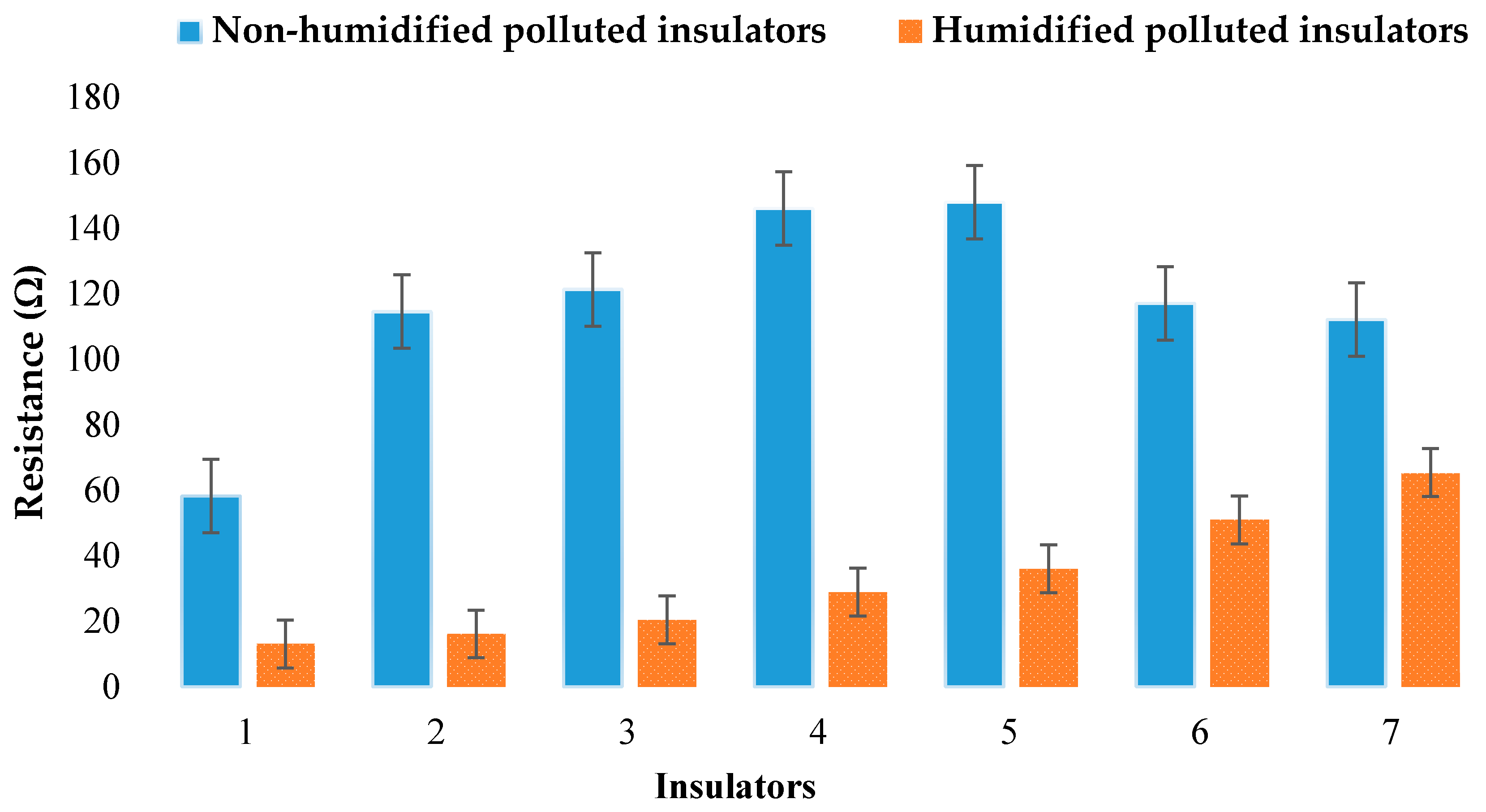
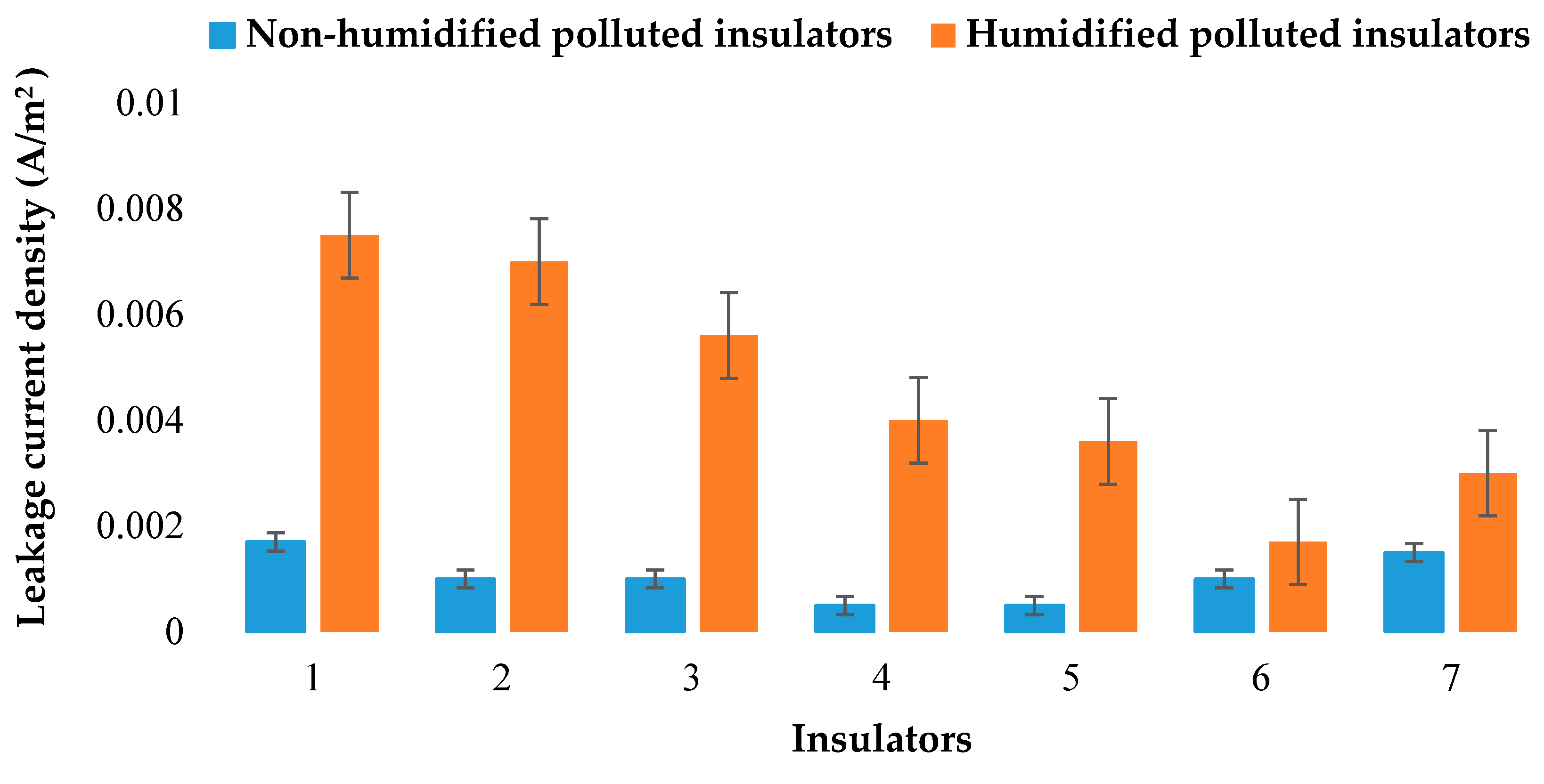
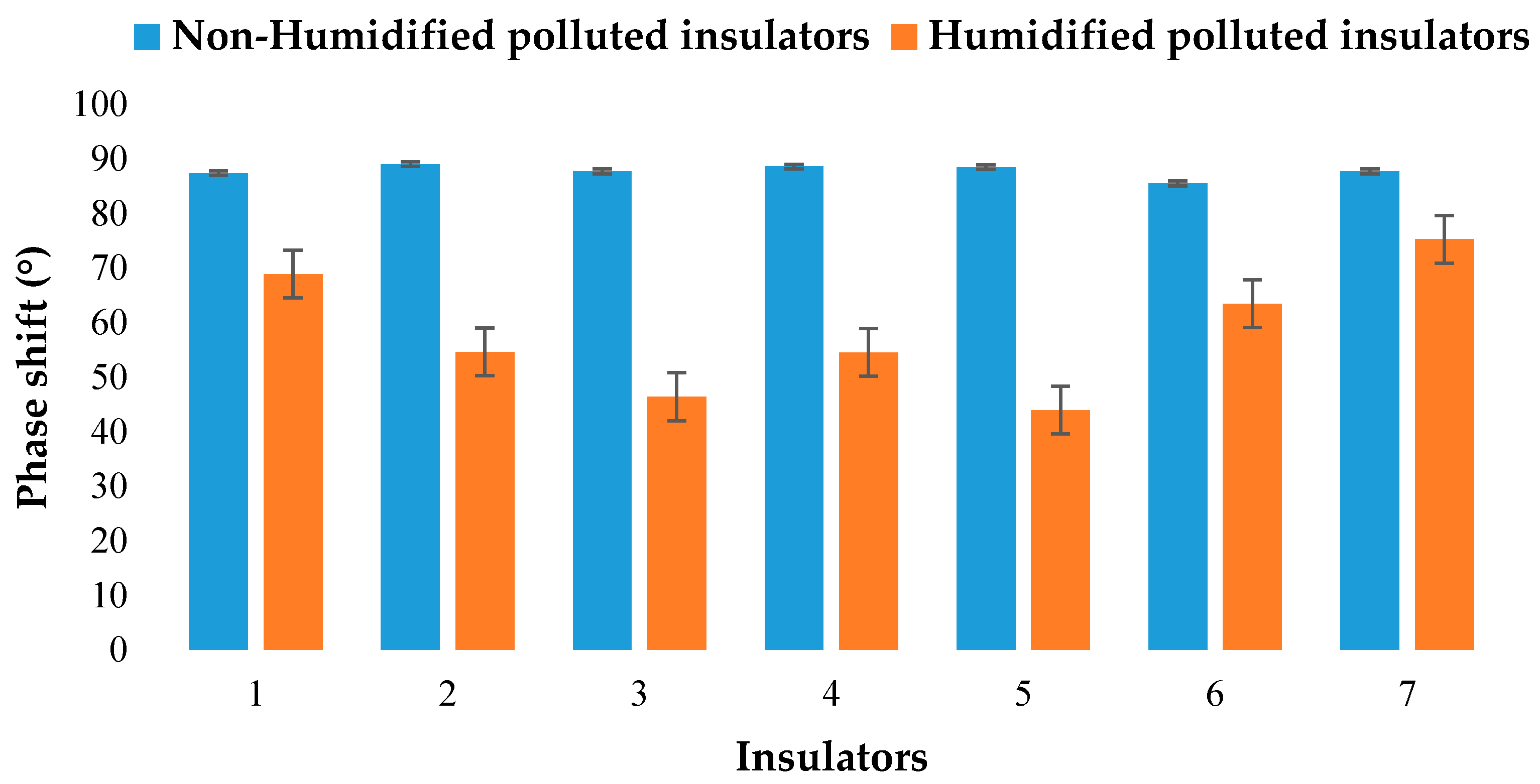
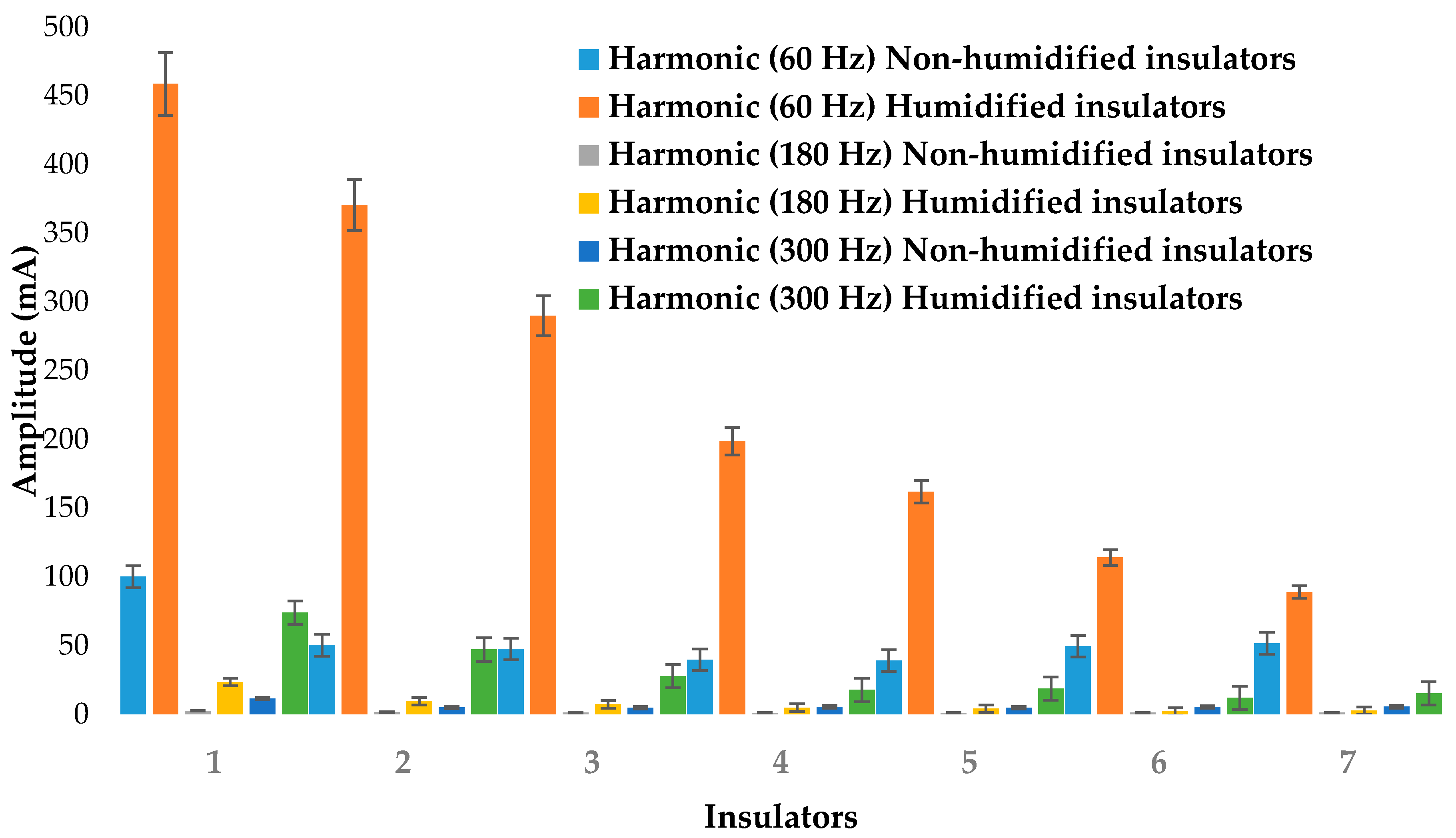
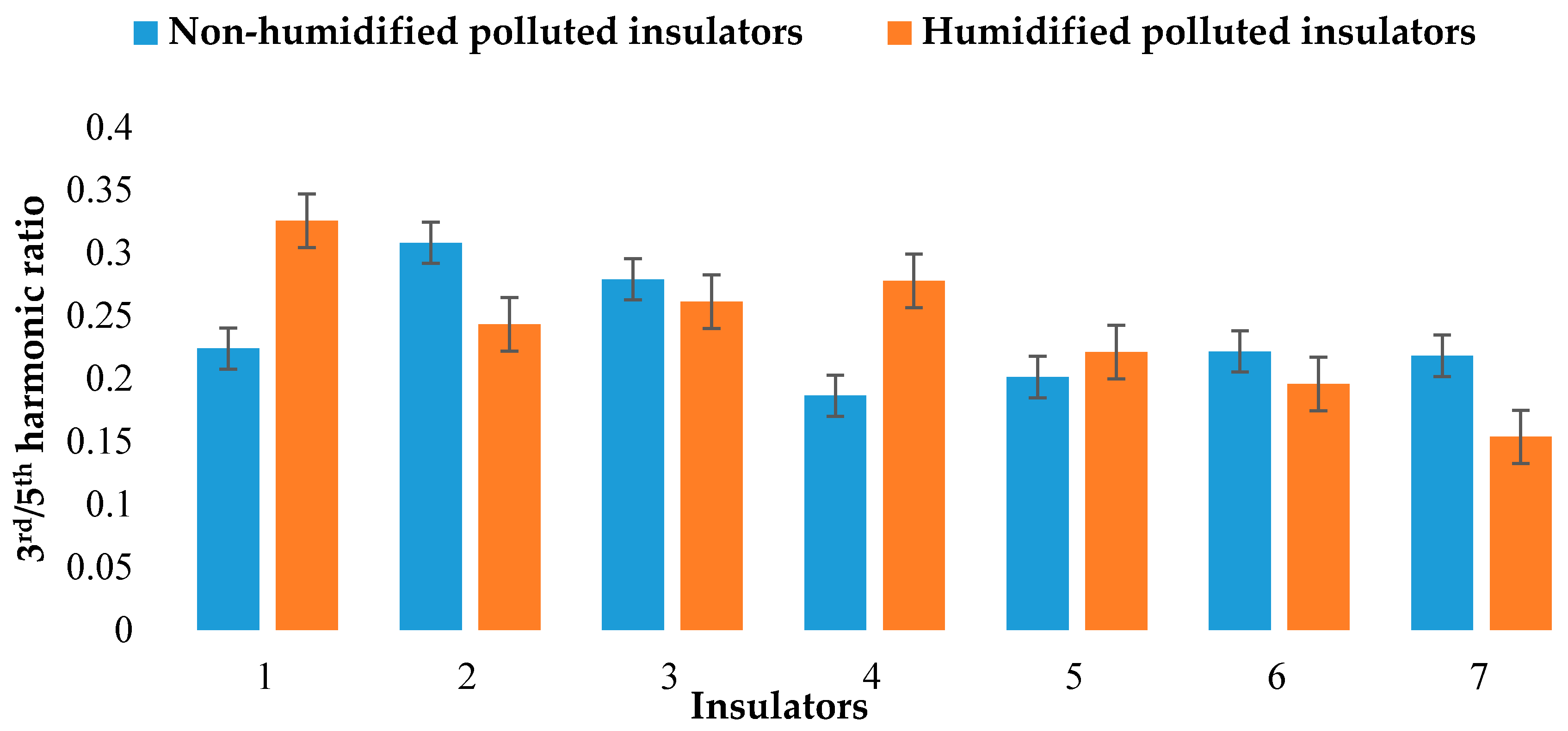
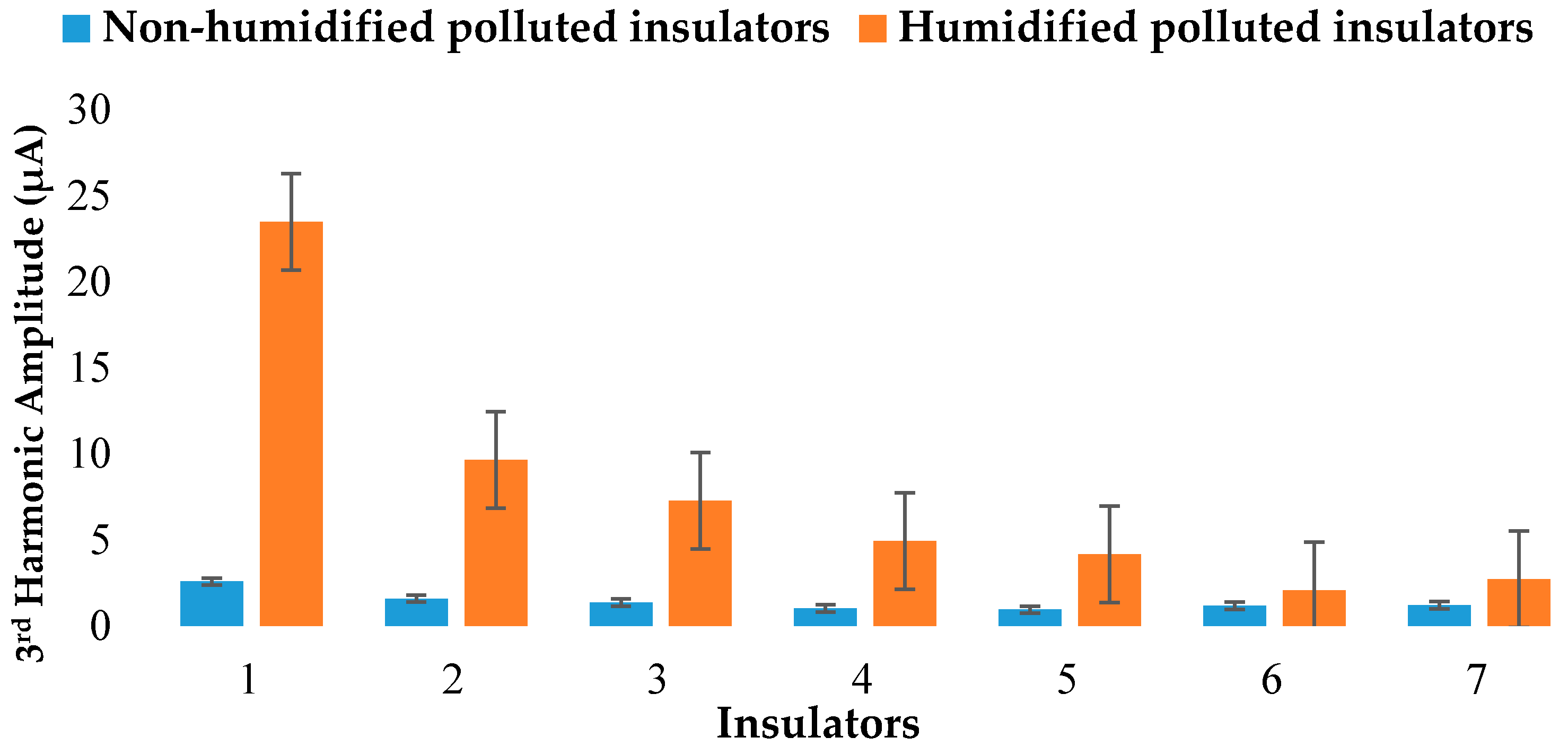
| Pollution Type | Source of Pollutant | Deposit Characteristics | Area |
|---|---|---|---|
| Rural areas | Soil dust | Low conductivity layer, effective rain washing | Large areas |
| Desert | Sand | High conductivity | Large areas |
| Coastal area | Sea salt | Very high conductivity, easily washed by rain | 10–20 km from the sea |
| Industrial | Steel mill, cocoa plants, chemical plants, generating stations, quarries | High conductivity, extremely difficult to remove, insoluble | Localized to the plant area |
| Mixed | Industry, Highway, desert | Very adhesive, medium conductivity | Localized to the plant area |
| Insulators/Areas | Salinity (mg/cm3) | ESDD (mg/cm2) | NSDD (mg/cm2) |
|---|---|---|---|
| 1 | 0.1944 | 0.1184 | 1.6800 |
| 2 | 0.2419 | 0.1408 | 5.0200 |
| 3 | 0.3050 | 0.2125 | 1.6300 |
| 4 | 0.0229 | 0.0307 | 0.0750 |
| 5 | 0.0525 | 0.0325 | 0.2800 |
| 6 | 0.0017 | 0.0010 | 0.0098 |
| 7 | 0.1662 | 0.1063 | 3.8100 |
| Site Pollution Severity | ESSD (mg/cm2) | NSDD (mg/cm2) |
|---|---|---|
| Light | 0–0.03 | 0.03–0.06 |
| Medium | 0.03–0.06 | 0.10–0.20 |
| High | 0.06–0.10 | 0.30–0.60 |
| Very High | >0.10 | >0.80 |
| Insulators/Areas | Pollution Level |
|---|---|
| 1 | Very high |
| 2 | Very high |
| 3 | Very high |
| 4 | Medium |
| 5 | High |
| 6 | Light |
| 7 | Very high |
© 2020 by the authors. Licensee MDPI, Basel, Switzerland. This article is an open access article distributed under the terms and conditions of the Creative Commons Attribution (CC BY) license (http://creativecommons.org/licenses/by/4.0/).
Share and Cite
Fofana, I.; N’cho, J.S.; Betie, A.; Hounton, E.; Meghnefi, F.; Yapi, K.M.L. Lessons to Learn from Post-Installation Pollution Levels Assessment of Some Distribution Insulators. Energies 2020, 13, 4064. https://doi.org/10.3390/en13164064
Fofana I, N’cho JS, Betie A, Hounton E, Meghnefi F, Yapi KML. Lessons to Learn from Post-Installation Pollution Levels Assessment of Some Distribution Insulators. Energies. 2020; 13(16):4064. https://doi.org/10.3390/en13164064
Chicago/Turabian StyleFofana, Issouf, Janvier Sylvestre N’cho, Amidou Betie, Epiphane Hounton, Fethi Meghnefi, and Kouba Marie Lucia Yapi. 2020. "Lessons to Learn from Post-Installation Pollution Levels Assessment of Some Distribution Insulators" Energies 13, no. 16: 4064. https://doi.org/10.3390/en13164064
APA StyleFofana, I., N’cho, J. S., Betie, A., Hounton, E., Meghnefi, F., & Yapi, K. M. L. (2020). Lessons to Learn from Post-Installation Pollution Levels Assessment of Some Distribution Insulators. Energies, 13(16), 4064. https://doi.org/10.3390/en13164064








